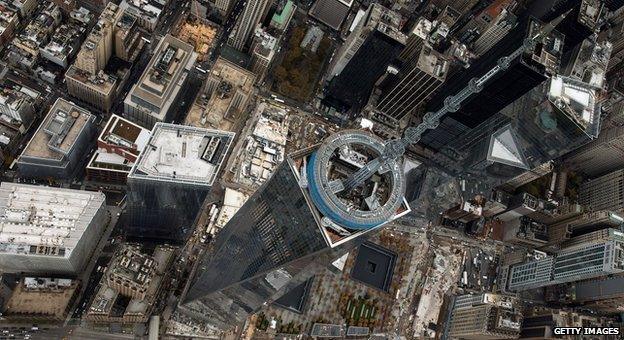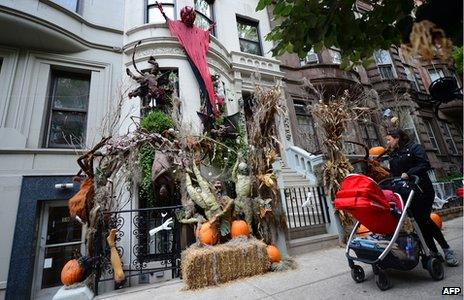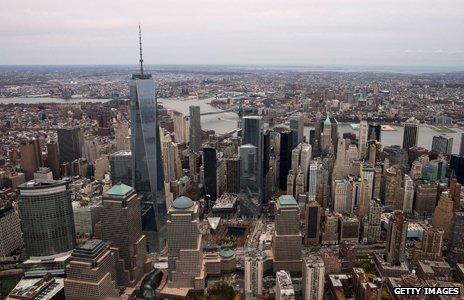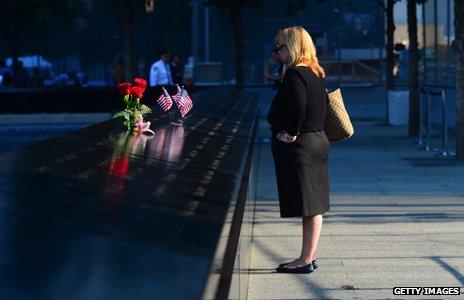A Point of View: Rebuilding after 9/11
- Published

Is the new World Trade Center a fitting memorial, asks Will Self.
One of the many activities that New Yorkers excel in is raising the dead. I was in New York in the days leading up to All Hallows' Eve and the doorsteps were festooned with fake cobwebs and elaborately carved pumpkins, while decoupages of witches on broomsticks made their appearance in the windows of shops and apartments.
But while these ghoulish and insubstantial resurrections were being adverted, a more solid re-erection was taking place, as the finishing touches were being put on One World Trade Center, the tallest of the skyscrapers that will replace the Twin Towers struck down by the terrorist attacks of 11 September 2001.
This year's Hallowe'en Parade theme was renewal - ostensibly the renewal of the city after the devastations of Hurricane Sandy that hit last October - but I cannot have been alone in seeing this as serendipitous.

For everywhere I walked in Lower Manhattan I could see the new World Trade Center staring down at me from over lesser rooftops, its shining facade expressing New Yorkers' deeper yearning for a renewal not simply of the city's physical structure, but of that more numinous entity, its soul - and by extension the soul of the entire United States.
My mother was brought up in New York, but we never visited the city together. Maybe this explains why my own relationship with Manhattan has a preternatural cast. Although I've never stayed there for extended periods, when wandering its stony canyons I often sense I'm inhabiting someone else's perspective - one of a deep and weary familiarity.
This feeling of deja vu haunts me, making me, I suspect, more finely attuned to New York's genius loci than mere reason would admit. Of course, the deeper renewal - or resurrection - that the city seeks is bound up not only with the rebuilding of the World Trade Center. A dozen years since, the grotesque singularity of the terrorist attacks continues to haunt the crowded streets and thronged squares - death came winging out of a clear-blue sky, borne on wings not demonic but prosaic. To lay the ghosts of 9/11 to rest, it is necessary for New York to both rebuild what was destroyed, and also to memorialise in a fitting way those who were murdered - but fitting for whom, exactly?
The rebuilding of the World Trade Center has proceeded by fits, starts, and with periodic convulsions of the civic body. The downtown site, mired in ground sacred to mammon, has mixed into it a complex mulch of private rights and public responsibilities: to harmonise these competing interests in the frozen music of architecture has proved a gruelling compositional task. The bombastic name Freedom Tower has long since fallen by the wayside, to be replaced by the defiantly workaday ascription, One World Trade Center. In time this edifice will be joined by several more to form another dense thicket of steely trunks and glassy leaves up-thrusting from the urban jungle, but for now number One stands proud of lower Manhattan's concrete canopy - all 104 storeys of it, that plus a telecommunications mast gives an overall height of 1,776 ft and makes it the tallest structure in the Western Hemisphere.

These feet are emblematic ones, by reason of which the so-called "war on terror" that's been waged by successive US administrations since 2001 becomes equated with America's Declaration of Independence. By extension, the radome that protects number One's battery of telemetric equipment is cast as a latter-day version of the eye atop the masonic pyramid on the American dollar bill. In this highly politicised calculus, the revolutionary war fought to free the American colonies from the yoke of British imperialism is of a piece with every other conflict the nation has fought in the succeeding centuries, whether they be wars of survival or conquest.
Is this right? Could such rhetoric - at once weighty and soaring - have been avoided? Somehow I doubt it. Courtesy of Skidmore Owings and Merrill, the architectural practice responsible for number One's design, I had the opportunity to become the eye in the pyramid - together with the manager of the project I was winched up the flank of the building to the very top, where, in the chilly late autumn sunlight he offered me a Magic Marker so I could add my own graffito to the ones that speckled a soaring rebar. Killjoy was there.
If my experience of New York always has a certain uncanniness, this was perhaps the strangest reviewing. I had last occupied this position almost exactly 20 years before when a friend and I took the mandatory tourist trip up to the viewing gallery of the old World Trade Center. What had struck me then was exactly the same phenomenon that I now experienced looking out from number One - the island of Manhattan lay beneath me like the prow of a 10-mile-long ship rammed into the hinterland of New York, while I occupied the crow's nest atop its loftiest mast. It is this reassumption of a cherished view that requires all of number One's 1,776 ft. Having formerly been able to stand on this summit, it was incumbent on those wishing to avenge the victims of the 11 September attacks that it be conquered again - because, you might say, it was once there. The view from the top of number One is thus psychically akin to the Stars and Stripes raised by the US Marines on the Japanese corpses littering the peak of Iwo Jima.
But is the vigour and confidence of the United States best served by such doomy pronouncements? The two sunken pools at the base of the tower that memorialise the victims also have a minatory feel. Placed so as to mimic the footings of the departed North and South towers, the unceasing waterfalls that purl down their obsidian sides are suggestive not of eternal life, but of a grim and ever-present Styx that office workers for decades to come will inch their way around rather than across. And down below, in the very bowels of Manhattan, the pools intrude into the strange subterranean spaces of the museum that's due to be dedicated next year - their bulky presences becoming another exhibit, alongside a wrecked fire truck and salvaged steel beams.

The relatives of the terrorists' victims have campaigned vigorously against these and other aspects of this strange exercise in museumification. Their argument is that their private grief should not be traduced by being incorporated into such a public display. But really, there was never any likelihood that what memorialised their loved ones would be modest or decorous, anymore than what replaced the fallen towers would be unassuming. Here, in New York, the twin vectors of international finance and national power merge together to produce a site so highly charged that the very atmosphere seems to crackle. The al-Qaeda affiliates understood this only too well, which was why they chose to strike at structures in which symbolism and reality were so completely interfused. For private grief to cry out against the nightmare of history itself would require a paradoxically public acknowledgement - that the 9/11 attacks, far from being acts of war, were rather singularly vicious personal crimes.
Christians frequently condemn the ghoulish goings-on associated with Halloween. Yet in America, a country that often prides itself on its piety, for the living to dress up as the dead has never been a more popular pursuit. The curious thing is that the state itself has started to play a part in this mummery, but then again, perhaps that's only to be expected, given that for the past 12 years its foreign policy has often seemed founded on trick or treating. As for the similarity to the conquest of Iwo Jima, there are these profound differences - the flag raised on the new World Trade Center will fly above the remains of America's victims rather than its enemies - moreover, this is no static image, but a living, working building.
Correction: An earlier version of this story incorrectly stated that the famous flag-raising photo on Iwo Jima was faked.
Follow @BBCNewsMagazine, external on Twitter and on Facebook, external